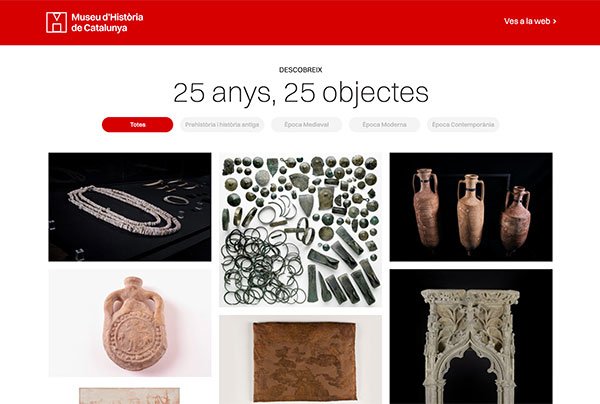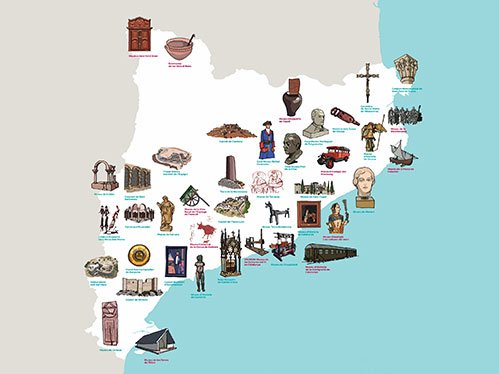Al canviar d'idioma no tots els continguts estan traduïts
The website is not fully translated
Al cambiar de idioma no todos los contenidos están traducidos
Al canviar d'idioma no tots els continguts estan traduïts
 Opening times
Opening times
 Location
Location
 Tickets
Tickets
 Admissions
Admissions
Opening times
Tuesday to Saturday, 10am to 7pm
Wednesdays, 10am to 8pm
Sundays and public holidays, 10am to 2.30pm
The ticket office and entrance are closed 30 minutes before closing time
CLOSED: Mondays that are not bank holidays, 1 and 6 January, 1 May, 18 May, 1 June, 25 and 26 December
Location
Address
Plaça de Pau Vila, 3
08039 Barcelona
Coordinates: 41.380900, 2.185693
Contact
932 254 700
mhc.cultura@gencat.cat
Fax 932 254 758
Group and school bookings:
932 254 244
Monday to Thursday: 10am-2pm and 3.30-5.30pm
Friday: 9.30am-2pm
mhcvisites.cultura@gencat.cat
Transport and access routes
Public transport
Buses V17, H14, D20, V15, V13, 39, 45, 51, 59 and 120
Metro L4 (yellow) Barceloneta
Train to Barcelona Estació de França
Barcelona Tourist Bus: red line; and Barcelona City Tour: eastern route; Museu d’Historia de Catalunya stop.
Parking
There are three paid-for car parks nearby: in Passeig Joan de Borbó, Moll d’Espanya and Moll de la Fusta.
Coaches have parking spaces available near the museum building.
“Bicing” bicycle hire in Plaça Pau Vila.
Admissions
Permanent exhibition
Temporary exhibitions
General admission: 4 euros
Reduced admission: 3 euros
Combined ticket
Permanent exhibition + temporary exhibition
General admission: 8 euros
Reduced admission: 6 euros
 Opening times
Opening times
 Location
Location
 Tickets
Tickets
 Admissions
Admissions
Opening times
Tuesday to Saturday, 10am to 7pm
Wednesdays, 10am to 8pm
Sundays and public holidays, 10am to 2.30pm
The ticket office and entrance are closed 30 minutes before closing time
CLOSED: Mondays that are not bank holidays, 1 and 6 January, 1 May, 18 May, 1 June, 25 and 26 December
Location
Address
Plaça de Pau Vila, 3
08039 Barcelona
Coordinates: 41.380900, 2.185693
Contact
932 254 700
mhc.cultura@gencat.cat
Fax 932 254 758
Group and school bookings:
932 254 244
Monday to Thursday: 10am-2pm and 3.30-5.30pm
Friday: 9.30am-2pm
mhcvisites.cultura@gencat.cat
Transport and access routes
Public transport
Buses V17, H14, D20, V15, V13, 39, 45, 51, 59 and 120
Metro L4 (yellow) Barceloneta
Train to Barcelona Estació de França
Barcelona Tourist Bus: red line; and Barcelona City Tour: eastern route; Museu d’Historia de Catalunya stop.
Parking
There are three paid-for car parks nearby: in Passeig Joan de Borbó, Moll d’Espanya and Moll de la Fusta.
Coaches have parking spaces available near the museum building.
“Bicing” bicycle hire in Plaça Pau Vila.
Admissions
Permanent exhibition
Temporary exhibitions
General admission: 4 euros
Reduced admission: 3 euros
Combined ticket
Permanent exhibition + temporary exhibition
General admission: 8 euros
Reduced admission: 6 euros
The end of prehistory
Bronze Age dwelling (space 2)
In the last periods of prehistory we find more complex societies, with some degree of specialization in trades, organized in settlements which by now are partly planned.
In this room there is a reconstruction of a Bronze Age hut from the 7th century BC, based on a study of the settlement in the Gàfols ravine, in Ginestar (Ribera d’Ebre). The house, which is narrow and elongated, was part of a small village with 17 precincts laid out along three streets. The adobe walls are raised on a stone base and on the inside they are plastered and decorated with ochre paintings. The roof, made of reeds and mud, rests on wooden beams.
Alongside the entrance to the house the store is raised on a platform that protects the food supplies from damp and animals. The fruit gathered in the wood and game complement a diet based on the harvest of cereals and pulses, which are then conserved in large ceramic containers. Beside the hearth we can observe the stone mills that produced flour after hours of hard labour. The discovery of clay weights to tense the threads of the loom has enabled us to deduce that each home made its own fabrics.

Opening times
Tuesday to Saturday, 10am to 7pm
Wednesdays, 10am to 8pm
Sundays and public holidays, 10am to 2.30pm
The ticket office and entrance are closed 30 minutes before closing time
CLOSED: Mondays that are not bank holidays, 1 and 6 January, 1 May, 18 May, 1 June, 25 and 26 December
Location
Address
Plaça de Pau Vila, 3
08039 Barcelona
Coordinates: 41.380900, 2.185693
Contact
932 254 700
mhc.cultura@gencat.cat
Fax 932 254 758
Group and school bookings:
932 254 244
Monday to Thursday: 10am-2pm and 3.30-5.30pm
Friday: 9.30am-2pm
mhcvisites.cultura@gencat.cat
Transport and access routes
Public transport
Buses V17, H14, D20, V15, V13, 39, 45, 51, 59 and 120
Metro L4 (yellow) Barceloneta
Train to Barcelona Estació de França
Barcelona Tourist Bus: red line; and Barcelona City Tour: eastern route; Museu d’Historia de Catalunya stop.
Parking
There are three paid-for car parks nearby: in Passeig Joan de Borbó, Moll d’Espanya and Moll de la Fusta.
Coaches have parking spaces available near the museum building.
“Bicing” bicycle hire in Plaça Pau Vila.
Admissions
Permanent exhibition
Temporary exhibitions
General admission: 4 euros
Reduced admission: 3 euros
Combined ticket
Permanent exhibition + temporary exhibition
General admission: 8 euros
Reduced admission: 6 euros




 Twitter
Twitter Facebook
Facebook